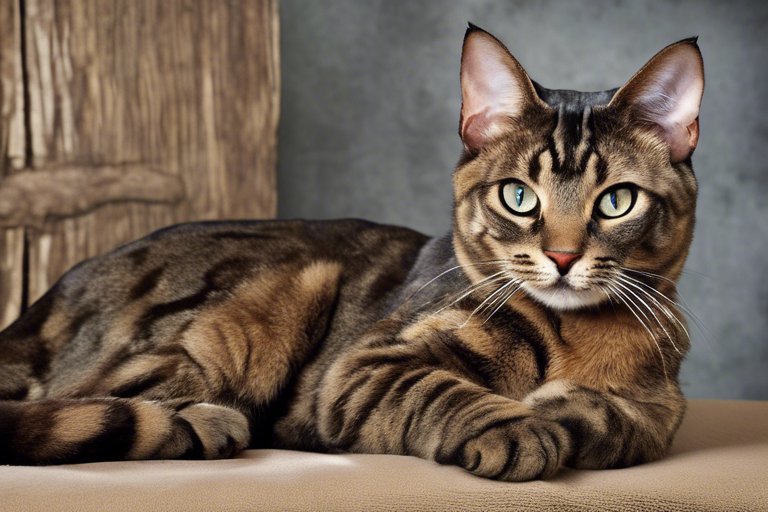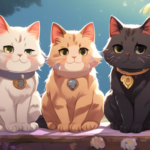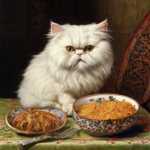Introduction
Brindle cats are a captivating and unique feline breed that showcases a mesmerizing coat pattern. The term “brindle” refers to a coat pattern characterized by streaks or stripes of different colors, creating a visually striking appearance. In this article, we will delve into the genetic factors behind brindle cats, explore the various coat patterns associated with brindling, discuss their temperament and health considerations, and provide grooming tips specific to this extraordinary feline breed.
Understanding the Genetics of Brindle Cats
To comprehend the origin of brindle cats, we must first explore the genetic code that influences their coat pattern and color. Cats possess specific genetic locations known as loci, where a variety of genes can be present. These genes determine the coat color and pattern of the cat. While brindling is commonly associated with animals like dogs, cats also have loci that influence their coat patterns.
One crucial locus in a cat’s DNA sequence is the agouti locus, which contains genes for coat patterns such as smoke, chinchilla, and silver-tipped coats. Interestingly, the brindle gene is absent from cats at this locus, distinguishing them from other animals. Another essential locus is the tabby locus, housing genes responsible for mackerel, blotched, spotted, or ticked tabby patterns.
The Brindle Coat Pattern in Cats
The mackerel tabby coat pattern is most likely to be described as brindle. Mackerel tabby stripes, which resemble brindling, were the original coat pattern of wild cat ancestors. Over time, breeders have developed alternative coat patterns by harnessing and replicating spontaneous genetic mutations. Some prominent cat breeds that often display mackerel tabby stripes include the Devon Rex, Cornish Rex, Bengal, Maine Coon, and American Bobtail.
Another coat pattern that can be described as brindle is the tortoiseshell coat. The tortoiseshell pattern arises due to the inheritance of instructions for producing either black-based or red-based coat pigments on the X sex chromosome. Male cats, with only one X chromosome, produce either black-based or red-based pigment throughout their bodies. However, female cats, with two X chromosomes, can inherit instructions for both pigment types, resulting in patches of skin producing different pigments. When the patches are small, tortoiseshell coats may resemble brindling.
Coat Color Modifications and Effects
In addition to the black-based and red-based pigments, cats can inherit genes that modify the quantity of black or red pigment produced. This modification can result in various brindle coat variations, such as brindle gray cats. The interplay between different genes and modifications contributes to the diverse and captivating appearances seen in brindle cats.

Distinctive Brindle Cat Breeds
While brindle is not specific to a particular breed, certain cat breeds are more commonly associated with brindle coats. These breeds possess distinct personality traits, grooming needs, and potential health concerns. Some notable cat breeds that often exhibit brindle coat patterns include:
- Devon Rex
- Cornish Rex
- Bengal
- Maine Coon
- American Bobtail
- British Shorthair
- Exotic Shorthair
- Japanese Bobtail
- Persian
- Ragamuffin
- Sphynx
- Peterbald
Each of these breeds brings its unique characteristics to the table, and prospective owners should consider their individual needs and preferences when choosing a brindle cat.
Temperament and Personality
As with any feline breed, the temperament of a brindle cat varies depending on factors such as breed and upbringing. Different cat breeds are associated with distinct personality traits. For instance, Bengals are known for their curiosity, playfulness, and intelligence, often exhibiting dog-like behavior. On the other hand, Persian cats are characterized as docile and affectionate companions.
The upbringing of a kitten also plays a vital role in shaping their personality. Kittens exposed to a wide range of positive experiences and socialization with humans before reaching seven weeks old tend to be more confident and eager to engage with their human counterparts. Familiarizing kittens with common household noises, such as vacuum cleaners and washing machines, helps them acclimate and reduces their sensitivity to these sounds.
Health Considerations for Brindle Cats
The coat patterns resembling brindling in cats, specifically the tortoiseshell pattern, are predominantly found in female cats due to the inheritance of the X sex chromosome. Therefore, health concerns commonly associated with female cats, such as spaying to prevent unwanted pregnancies, should be considered.
Aside from the coat pattern, brindle cats may also be susceptible to health issues prevalent in their respective breeds. Persian cats, for example, are prone to breathing difficulties and eye injuries due to their flat faces. Bengal cats have a higher incidence of heart disease compared to other cat breeds, while larger brindle breeds like the Maine Coon are more susceptible to joint diseases such as hip dysplasia.
Grooming Brindle Cats
Grooming requirements for brindle cats vary depending on their breed and coat length. Short-haired domestic cats, Bengals, and Cornish Rexes with brindle patterns generally require minimal assistance in maintaining cleanliness. However, long-haired domestic cats, such as Maine Coons and Ragamuffins, necessitate regular brushing to remove dirt, debris, and prevent tangles.
Hairless cats, like the Sphynx and Peterbald, with brindle patterns on their skin, require regular baths to eliminate excess oils and prevent skin conditions like acne. It is crucial to consider the specific grooming needs of each breed to ensure the health and well-being of brindle cats.
Conclusion
Brindle cats are a captivating and diverse feline breed, boasting unique coat patterns that set them apart from other cats. Understanding the genetics behind brindle coats and the various coat patterns associated with them allows enthusiasts to appreciate the complexity and beauty of these feline companions. By considering breed-specific temperaments, health considerations, and grooming needs, potential brindle cat owners can make informed decisions that align with their preferences and provide optimal care for their beloved pets.
Remember, brindle cats are not just visually stunning; they are also loving and loyal companions, ready to bring joy and excitement to any household fortunate enough to welcome them into their lives.






